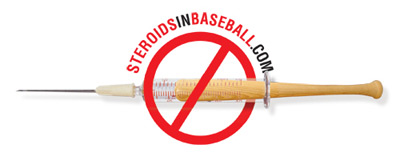Steroid Hall of Shame | Balco Timeline | Steroid Timeline | Mitchell Report




Home Page
Steroid Overview
Steroid Timeline: From Germany to USA
Commissioners and Controversy
- Kenesaw Landis
- Albert Chandler
- Ford Frick
- Colonel Eckert
- Bowie Kuhn
- Peter Uberroth
- A. Bartlett Giamatta
- Francis Vincent
- Alan Selig
Balco Timeline
Mitchell Report (409 pg pdf)
2002-06 Collective Bargaining Agreement (pdf)
2007-11 Collective Bargaining Agreement (pdf)
Steroids Overview
We frequently hear the term anabolic steroid, but few of us really comprehend what it means. What is anabolic, what is androgenic, and why one characteristic (anabolic) and not the other (androgenic)? The following information is designed to eliminate most, if not all, of the public confusion and misunderstanding relevant to anabolic steroids and, more specifically, anabolic-androgenic steroids.
We should probably begin by conceding the fact that the use of performance-enhancing drugs is nothing new or unusual in either amateur or professional sports. Indeed, the use of steroids and other drugs to enhance athletic performance has occurred with ever-increasing frequency since the mid-1950s.
Germany first developed steroids in the 1930s, initially experimenting on dogs and, subsequently, on German soldiers. The Germans discovered that soldiers were able to retain their health and vitality despite suffering from malnutrition and other wartime ailments. The Germans were not overly concerned with the possibilities of any long-term effects of steroid use.
Soviet and other European weightlifters began using steroids with dramatic results. They rather handily broke most of the world weightlifting records at the 1952 Olympics (Helsinki).
During this timeframe, Dr. John Ziegler - the U.S. Olympic team physician - decided to investigate the sudden increase in Soviet athletic abilities. Dr. Ziegler's interest was whetted when he learned, over cocktails with Soviet contemporaries in 1954, that testosterone derivatives were being used to enhance Soviet athletic performances. Within four years, Dr. Ziegler was administering a synthetic testosterone (dianabol) to the U.S. Olympic weightlifting team. During the next decade, the use of dianabol and other synthetic drugs became commonplace in strength-related sports. As a further example, professional football players were introduced to dianabol when, in 1963, Alvin Roy, strength coach of the San Diego Chargers, served the drug to his players at breakfast. The term "Breakfast of Champions" had taken on an entirely new meaning.
The athletic success of a few became the dream of many, and performance-enhancing drug "experiments" began in a diversity of athletic specialties. Shot putters, javelin throwers, jumpers, short- and middle-distance runners, and many other track and field athletes tried the drugs in an attempt to improve their performances. Many of these training experiments were facilitated by the upcoming 1968 Olympics (Mexico City).
During the 1970s, it was common knowledge that steroids, as well as amphetamines, were being used by athletes in all U.S. major league sports. The use of steroids became so widespread that their oversight was assigned to the FDA through the passing of a 1981 amendment to the Food, Drug, and Cosmetic Act requiring that steroids be prescribed by a physician. The thinking was that steroids would be used for medical reasons only and, in the off-chance they were used for nonmedical, athletic performance-enhancement purposes, their distribution and use would have to be overseen by a physician. There was no movement made at this point to classify steroids as a controlled substance.
Later in the 1980s, it became obvious that the drugs and steroids prescribed by physicians were easy to obtain and abuse. At the point at which steroid use was expanded to include high school athletes, shocked federal government officials took action. In 1988, they enacted legislation to again amend the Food, Drug, and Cosmetic Act, establishing criminal penalties for unauthorized distributors (black market traffickers). Steroids that were sold for nonmedical use would be seized, and the traffickers would be prosecuted and jailed. Steroids, however, were still not considered controlled substances. In order for a drug to become controlled, its use has to lead to some form of measurable physical or psychological dependence. Dependence was not the issue with steroids. At this point in time, the government was attempting to apply moderate controls to an athletic drug problem. From 1958 (when steroids were first used by U.S. Olympic weightlifters) to 1988, steroids had found their way into every level of amateur and professional sports.
Congress took further action. Immediately following the 1988 amendment to the Food, Drug, and Cosmetic Act, legislators held hearings on whether steroids should be classified as controlled substances. Testimonies from every corner of the medical and psychological fields agreed that the use of steroids did not meet the criteria set for controlling drugs, i.e., physical or psychological dependence. (Eventually, the American Medical Association publicly came out against the idea of controlling steroids.) Nevertheless, both amateur and professional athletes, trainers, and coaches - from every sporting level - testified that steroids created an unnatural and unfair athletic advantage. Congress realized that the abuse of steroids was a tremendous problem that would only get worse if nothing were done.
Congress could not argue with the information provided by the medical community. At that time there was no link between steroid use and dependence. In order to address the athletic cheating problem, Congress passed the Anabolic Steroid Control Act (1990). The legislation was signed into law by President George H. Bush on November 29, 1990. This law made the unauthorized distribution, possession, and use of anabolic steroids a federal offense punishable by up to one year in jail and a fine of up to $1,000. In this legislation, an anabolic steroid was described as any drug or hormonal substance chemically or pharmacologically related to testosterone that promoted muscle growth. The description went on to list some 21 different testosterone and hormonal derivatives specifically related to muscle growth, as well as any muscle growth-promoting salts.
With this measure, Congress had worked toward controlling the anabolic qualities of the anabolic-androgenic steroids. But, what about the androgenic qualities? Both terms anabolic and androgenic have Greek origins. Anabolic translates to mean build. Androgenic translates to roughly mean masculinize. Testosterone's natural androgenic effects trigger the maturing of the male reproductive system in puberty. These effects include the growth of body hair, the deepening of the voice, and acne. This was a problem for female athletes when steroids were first introduced back in the late 1950s and early 1960s. Through chemical refinements, however, the androgenic effects are no longer present in many of the derivatives now used. Instead, the derivatives that promote the anabolic effects - the building of muscles - are used. That is the reason the term anabolic is specifically used when referring to steroid use. Athletes are not concerned with harnessing the androgenic effects of steroids. Once this legislation was passed, about half the states in the U.S. immediately revised their laws to coincide with the federal version. The others dragged their feet.
Most recently, on June 3, 2004, Congress overwhelmingly passed the Anabolic Steroid Control Act of 2004 (HR 3866). It was an important step toward a nationwide ban on over-the-counter sales of dietary supplements that contain anabolic steroid-like ingredients and their precursors. This 2004 amendment modified the 1990 definition of anabolic steroid to include certain steroid precursors, e.g., tetrahydrogestrinone and androstenedione, and to exclude dehydroepiandrosterone. It also doubled the maximum penalty for anybody convicted of manufacturing, distributing, or possessing with intent to distribute an anabolic steroid within 1,000 feet of a sports facility. Since then, there have been studies, television investigations, and even a congressional hearing. But nothing has changed - the law remains as it was on June 3, 2004.
This website & Syringe Logo are owned and copywritten by Allan Doherty 2006 - 2009.